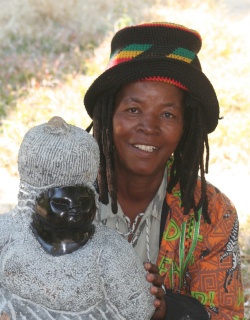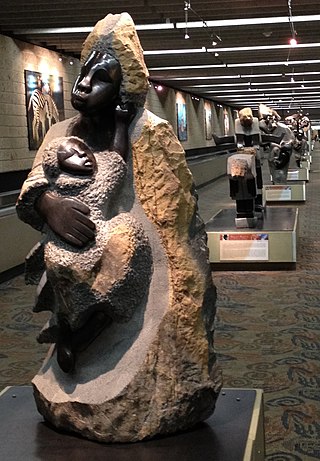Related Research Articles

The Chapungu Sculpture Park is a renowned cultural landmark and sculpture garden in Msasa, Harare, Zimbabwe, which displays the work of Zimbabwean stone sculptors. Spanning over 15 acres of landscaped gardens, the park is dedicated to showcasing the rich heritage of African stone sculpture.

Tapfuma Gutsa is a Zimbabwean sculptor.
Nicholas Mukomberanwa, was a Zimbabwean sculptor and art teacher. He was among the most famous protégés of the Workshop School at the National Gallery of Zimbabwe. He was a mentor to the Mukomberanwa Family of sculptors. Mukomberanwa married his first wife, sculptor Grace, in 1965 and they had eight children. In 1965, he decided to end his career with the police to become a sculptor full-time. He continued to hone his skills over the following decade, developing one of the most distinctive personal styles found in his generation of Zimbabwean stone sculptors. The gambit paid off, and by the late 1970s and in the 1980s his work was being shown in many venues. His work has been exhibited in galleries around the world. He also became mentor to many artists in Zimbabwe, including his children Anderson Mukomberanwa, Ennica Mukomberanwa, Lawrence Mukomberanwa, Netsai Mukomberanwa, Taguma Mukomberanwa,Tendai Mukomberanwa and nephew, Nesbert Mukomberanwa who are also sculptors. He remains one of Zimbabwe's most famous artists.
Bernard Matemera was a Zimbabwean sculptor. The sculptural movement of which he was part is usually referred to as "Shona sculpture", although some of its recognised members are not ethnically Shona. His whole professional career was spent at the Tengenenge Sculpture Community, 150 km north of Harare near Guruve.
Boira Mteki, was a Zimbabwean sculptor and educator.

Joram Mariga has been called the “Father of Zimbabwean Sculpture” because of his influence on the local artistic community starting in the 1950s and continuing until his death in 2000. The sculptural movement of which he was part is usually referred to as “Shona sculpture”, although some of its recognised members are not ethnically Shona.
John Takawira, was a Zimbabwean sculptor. The background to the sculptural movement of which he was a leading member is given in the article on Shona art.

Henry Munyaradzi, also known as Henry Munyaradzi Mudzengerere, was a Zimbabwean sculptor. The sculptural movement of which he was part is usually referred to as "Shona sculpture", although some of its recognised members are not ethnically Shona. He worked initially at the Tengenenge Sculpture Community, 150 km north of Harare near Guruve, which he joined in 1967. In that Community, and ultimately in the wider world of lovers of Zimbabwean art, he was known simply as 'Henry'.
Square Chikwanda is a Zimbabwean sculptor, living and working in Harare, Zimbabwe. He first learned his art from his father, also a Zimbabwean sculptor.
Joseph Ndandarika was a Zimbabwean sculptor known for his figurative works.

Colleen Madamombe (1964–2009) was a Zimbabwean sculptor working primarily in stone. Her work expresses themes of womanhood, motherhood, and tribal Matriarchy.
Coster Balakasi is a Zimbabwean sculptor.

Fanizani Akuda (1932–2011), also known as Fanizani Phiri, was a Zimbabwean sculptor. He was a member of the sculptural movement "Shona sculpture", although he and some others of its recognised members were not ethnically Shona. He worked initially at the Tengenenge Sculpture Community, 150 km north of Harare near Guruve, which he joined in 1966.
Crispen Chakanyuka was a Zimbabwean sculptor.
Sylvester Mubayi was a Zimbabwean sculptor.

Agnes Nyanhongo is a Zimbabwean stone sculptor.
Zimbabwean art includes decorative esthetics applied to many aspects of life, including art objects as such, utilitarian objects, objects used in religion, warfare, in propaganda, and in many other spheres. Within this broad arena, Zimbabwe has several identifiable categories of art. It is a hallmark of African cultures in general that art touches many aspects of life, and most tribes have a vigorous and often recognisable canon of styles and a great range of art-worked objects. These can include masks, drums, textile decoration, beadwork, carving, sculpture, ceramic in various forms, housing and the person themselves. Decoration of the body in permanent ways such as scarification or tattoo or impermanently as in painting the body for a ceremony is a common feature of African cultures.

Sculpture and in particular stone sculpture is an art for which Zimbabwe is well known around the world.

Tengenenge is a community of artists and their families located in the Guruve District of Zimbabwe. It has achieved international recognition because of the large number of sculptors who have lived and worked there since 1966. These include Fanizani Akuda, Bernard Matemera, Sylvester Mubayi, Henry Munyaradzi and Bernard Takawira.
References
- ↑ Obituary by J Zilberg Archived 13 December 2010 at the Wayback Machine
- ↑ Obituary by B Chigama Archived 18 July 2011 at the Wayback Machine
- ↑ Obituary in The Herald, Zimbabwe
- ↑ Obituary in the Sydney Morning Herald
- ↑ "Obituary by M Makoni". Archived from the original on 6 May 2011. Retrieved 30 January 2011.
- ↑ See biography of Henry Munyaradzi
- ↑ Winter-Irving C, 2002